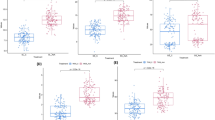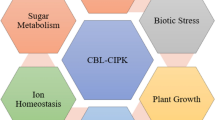Abstract
Reed plants (Phragmites communis (Linn.) Trin) are hydrophilic perennial grasses growing in fresh and brackish waters. These plants readily adapt to arid and high salinity conditions; however, their resistance mechanism against abiotic stresses, especially high salinity, is largely unknown. In the present study, we cloned a glutathione reductase gene from P. communis and investigated its role in conferring salt tolerance in reed plants. The expression of PhaGR at the transcriptional level was affected by multiple abiotic stresses including NaCl, Cd2+, heat, cold, PEG 6000, and abscisic acid (ABA). Furthermore, NaCl and Cd2+ could increase its expressions at the translational level. NaCl and Cd2+ also increased the biosynthesis of soluble protein and reduced glutathione (GSH). Reed seedlings that were challenged with NaCl showed higher levels of GR activities, which corroborated our gene expression data. The increase in GR possibly increased the salt tolerance of reed plants through GSH production. Thus, PhaGR is a potential target gene in improving the salt tolerance of crops through genetic manipulation.






Similar content being viewed by others
Abbreviations
- APX:
-
Ascorbate peroxidase
- CAT:
-
Catalase
- GSH:
-
Reduced glutathione
- ORF:
-
Open reading frame
- PhaGRC:
-
Phragmites communis glutathione reductase
- RACE:
-
Rapid amplification of cDNA ends
- ROS:
-
Reactive oxygen species
- SOD:
-
Superoxide dismutase
- GR:
-
Glutathione reductase
- GSSG:
-
Oxidized glutathione
References
Vij, S., & Tyagi, A. K. (2007). Emerging trends in the functional genomics of the abiotic stress response in crop plants. Plant Biotechnology Journal, 5, 361–380.
Sreenivasulu, N., Sopory, S. K., & Kavi Kishor, P. B. (2007). Deciphering the regulatory mechanisms of abiotic stress tolerance in plants by genomic approaches. Gene, 388, 1–13.
Mittler, R. (2006). Abiotic stress, the field environment and stress combination. Trends in Plant Science, 11, 15–19.
Vinocur, B., & Altman, A. (2005). Recent advances in engineering plant tolerance to abiotic stress: achievements and limitations. Current Opinion in Biotechnology, 16, 123–132.
Kasuga, M., Liu, Q., Miura, S., Yamaguchi-Shinozaki, K., & Shinozaki, K. (1999). Improving plant drought, salt, and freezing tolerance by gene transfer of a single stress-inducible transcription factor. Nature Biotechnology, 17, 287–291.
Zhu, J. K. (2002). Salt and drought stress signal transduction in plants. Annual Review of Plant Biology, 53, 247–273.
Zhang, J. L., & Shi, H. (2003). Physiological and molecular mechanisms of plant salt tolerance. Photosynthesis Research, 115, 1–22.
Apel, K., & Hirt, H. (2004). Reactive oxygen species: metabolism, oxidative stress, and signal transduction. Annual Review of Plant Biology, 55, 373–399.
Tripathy, B. C., & Oelmüller, R. (2012). Reactive oxygen species generation and signaling in plants. Plant Signaling & Behavior, 7, 1621–1633.
Choudhury, S., Panda, P., Sahoo, L., & Panda, S. K. (2013). Reactive oxygen species signaling in plants under abiotic stress. Plant Signaling & Behavior, 8(4), e23681.
Suzuki, N., Koussevitzky, S., Mittler, R., & Miller, G. (2012). ROS and redox signalling in the response of plants to abiotic stress. Plant, Cell and Environment, 35, 259–270.
Xu, J., Duan, X., Yang, J., Beeching, J. R., & Zhang, P. (2013). Enhanced reactive oxygen species scavenging by overproduction of superoxide dismutase and catalase delays postharvest physiological deterioration of cassava storage roots. Plant Physiology, 161, 1517–1528.
Lin, K. H., & Puu, S. F. (2010). Tissue- and genotype-specific ascorbate peroxidase expression in sweet potato in response to salt stress. Biologia Plantarum, 54, 664–670.
Gill, S. S., Anjum, N. A., Hasanuzzaman, M., Gill, R., Trivedi, D. K., Ahmad, I., Pereira, E., & Tuteja, N. (2013). Glutathione and glutathione reductase: a boon in disguise for plant abiotic stress defense operations. Plant Physiology and Biochemistry, 70, 204–212.
Han, R. M., Zhang, J. P., & Skibsted, L. H. (2012). Reaction dynamics of flavonoids and carotenoids as antioxidants. Molecules, 17, 2140–2160.
Havaux, M., Ksas, B., Szewczyk, A., Rumeau, D., Franck, F., Caffarri, S., & Triantaphylidès, C. (2009). Vitamin B6 deficient plants display increased sensitivity to high light and photo-oxidative stress. BMC Plant Biology, 9, 130.
Jithesh, M. N., Prashanth, S. R., Sivaprakash, K. R., & Parida, A. K. (2006). Antioxidative response mechanisms in halophytes: their role in stress defense. Journal of Genetics, 85, 237–254.
Takahashi, R., Nishio, T., Ichizen, N., & Takano, T. (2007). High-affinity K+ transporter PhaHAK5 is expressed only in salt-sensitive reed plants and shows Na+ permeability under NaCl stress. Plant Cell Reports, 26, 1673–1679.
Takahashi, R., Liu, S., & Takano, T. (2007). Cloning and functional comparison of a high-affinity K+ transporter gene PhaHKT1 of salt-tolerant and salt-sensitive reed plants. Journal of Experimental Botany, 58, 4387–4395.
Saitou, N., & Nei, M. (1987). The neighbor-joining method: a new method for reconstructing phylogenetic trees. Molecular Biology and Evolution, 4, 406–425.
Rao, M. V., Hale, B. A., & Ormrod, D. P. (1995). Amelioration of ozone-induced oxidative damage in wheat plants grown under high carbon dioxide (role of antioxidant enzymes). Plant Physiology, 109, 421–432.
Brehe, J. E., & Burch, H. B. (1976). Enzymatic assay for glutathione. Analytical Biochemistry, 74, 189–197.
Laemmli, U. K. (1970). Cleavage of structural proteins during the assembly of the head of bacteriophage T4. Nature, 227, 680–685.
Madamanchi, N. R., Anderson, J. V., Alscher, R. G., Cramer, C. L., & Hess, J. L. (1992). Purification of multiple isoforms of glutathione reductase from pea (Pisum sativum L.) seedlings and enzyme levels in O. fumigated pea leaves. Plant Physiology, 100, 138–145.
Bradford, M. (1976). A rapid and sensitive method for the quantitation of microgram quantities of protein utilizing the principle of protein-dye binding. Analytical Biochemistry, 72, 248–254.
Mittler, R. (2002). Oxidative stress, antioxidants and stress tolerance. Trends in Plant Science, 7, 405–410.
Lee, H., Jo, J., & Son, D. (1998). Molecular cloning and characterization of the gene encoding glutathione reductase in Brassica campestris. Biochimica et Biophysica Acta, 1995, 309–314.
Tahmasebi, A., Aram, F., Ebrahimi, M., Mohammadi, D. M., & Ebrahimie, E. (2012). Genome-wide analysis of cytosolic and chloroplastic isoforms of glutathione reductase in plant cells. Plant Omics, 5, 94–102.
Kataya, A. R., & Reumann, S. (2010). Arabidopsis glutathione reductase 1 is dually targeted to peroxisomes and the cytosol. Plant Signaling & Behavior, 5, 171–175.
Peerzada, Y. Y., Khalid Ul R. H., Ruby C., & Parvaiz A. (2012) Role of glutathione reductase in plant abiotic stress. Abiotic Stress Responses in Plants, 149–158.
Foyer, C., Lelandais, M., Galap, C., & Kunert, K. J. (1991). Effects of elevated cytosolic glutathione reductase activity on the cellular glutathione pool and photosynthesis in leaves under normal and stress conditions. Plant Physiology, 97, 863–872.
Mullineaux, P. M., & Creissen, G. P. (1997). Glutathione reductase: regulation and role in oxidative stress. In J. G. Scandalios (Ed.), Oxidative stress and the molecular biology of antioxidants (pp. 667–713). New York: Cold Spring Harbor Laboratory Press.
Lascano, H. R., Gómez, L. D., Casano, L. M., & Trippi, V. S. (1998). Changes in glutathione reductase activity and protein content in wheat leaves and chloroplasts exposed to photooxidative stress. Plant Physiology and Biochemistry, 36, 321–329.
Romero-Puertas, M. C., McCarthy, I., Gómez, M., Sandalio, L. M., Corpas, F. J., Del Río, L. A., & Palma, J. M. (2004). Reactive oxygen species-mediated enzymatic systems involved in the oxidative action of 2,4-dichlorophenoxyacetic acid. Plant, Cell and Environment, 27, 1135–1148.
Contour-Ansel, D., Torres-Franklin, M. L., De Carvalho, M. H. C., & Arcy-Lameta, A. (2006). Glutathione reductase in leaves of cowpea: cloning of two cDNAs, expression and enzymatic activity under progressive drought stress, desiccation and abscisic acid treatment. Annals of Botany, 98, 1279–1287.
Liu, Y. J., Yuan, Y., Liu, Y. Y., Liu, Y., Fu, J. J., Zheng, J., & Wang, G. Y. (2012). Gene families of maize glutathione-ascorbate redox cycle respond differently to abiotic stresses. Journal of Plant Physiology, 169, 183–192.
Eyidogan, F., & Oz, M. T. (2005). Effect of salinity on antioxidant responses of chickpea seedlings. Acta Physiologiae Plantarum, 29, 485–493.
Sharma, P., & Dubey, R. S. (2005). Modulation of nitrate reductase activity in rice seedlings under aluminium toxicity and water stress: role of osmolytes as an enzyme protectant. Journal of Plant Physiology, 162, 854–864.
Kumar, A., & Majeti, N. V. (2014). Proteomic responses to lead-induced oxidative stress in Talinum triangulare Jacq. (Willd.) roots: identification of key biomarkers related to glutathione metabolisms. Environmental Science and Pollution Research, 21, 8750–8764.
Diego, A. M., Marco, A. O., Carlos, A. M., & José, C. (2003). Photosynthesis and activity of superoxide dismutase, peroxidase and glutathione reductase in cotton under salt stress. Environmental and Experimental Botany, 49, 69–76.
Gamble, P. E., & Burke, J. J. (1984). Effect of water stress on the chloroplast antioxidant system. Plant Physiology, 76, 615–621.
Acknowledgments
This work was supported by the National Natural Science Foundation of China (No. 31201185, No. 31000128, No. 31370296, No. 30870199), by the Promotive Research Fund for Excellent Young and Middle-aged Scientists of Shandong Province (BS2010SW036), and by the Shandong Provincial Natural Science Foundation of China (No. ZR2011CQ013, No. ZR2011CM044).
Author information
Authors and Affiliations
Corresponding author
Electronic supplementary material
Below is the link to the electronic supplementary material.
Supplementary Table 1
Sequences of primers used (DOCX 14 kb)
Rights and permissions
About this article
Cite this article
Zhang, X., Quan, G., Wang, J. et al. Functional Validation of Phragmites communis Glutathione Reductase (PhaGR) as an Essential Enzyme in Salt Tolerance. Appl Biochem Biotechnol 175, 3418–3430 (2015). https://doi.org/10.1007/s12010-015-1514-5
Received:
Accepted:
Published:
Issue Date:
DOI: https://doi.org/10.1007/s12010-015-1514-5




